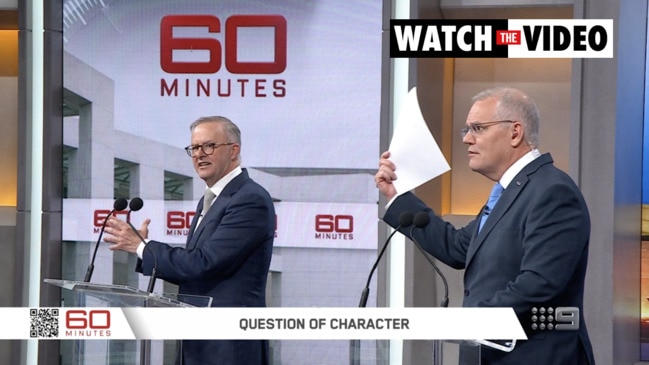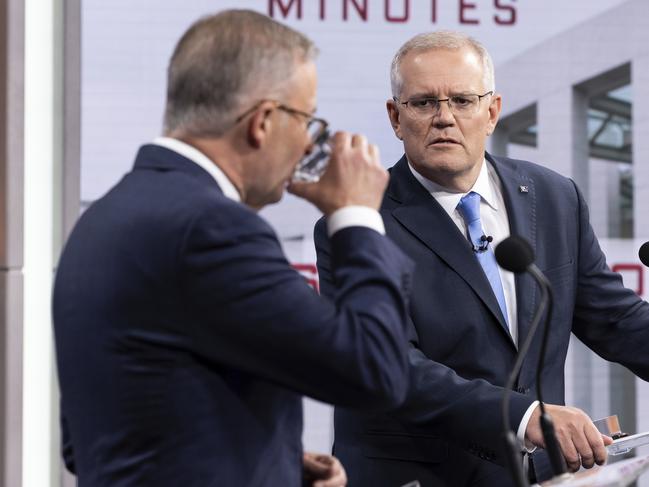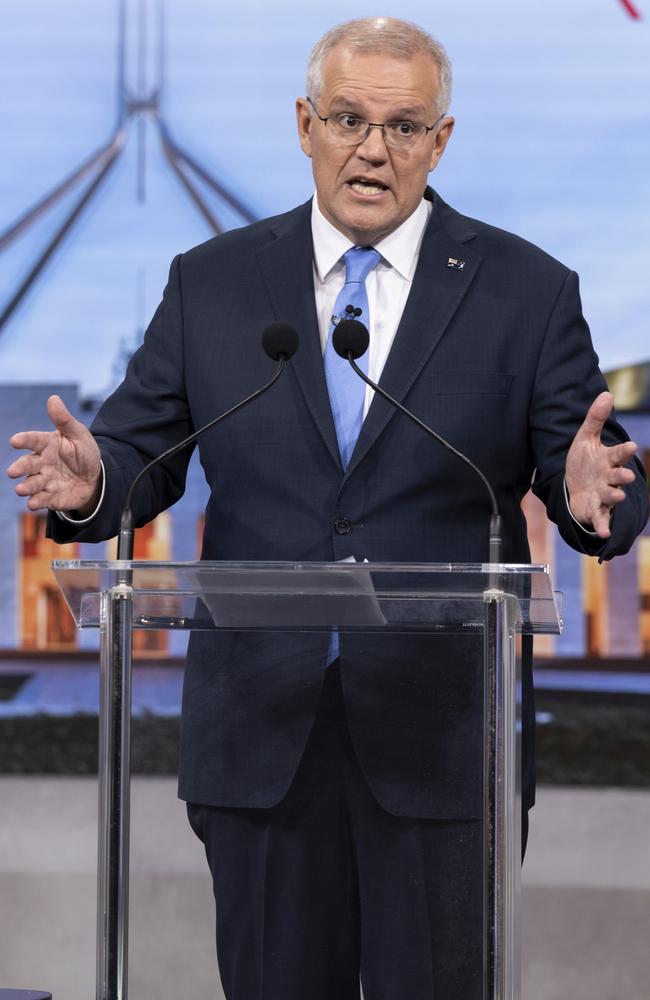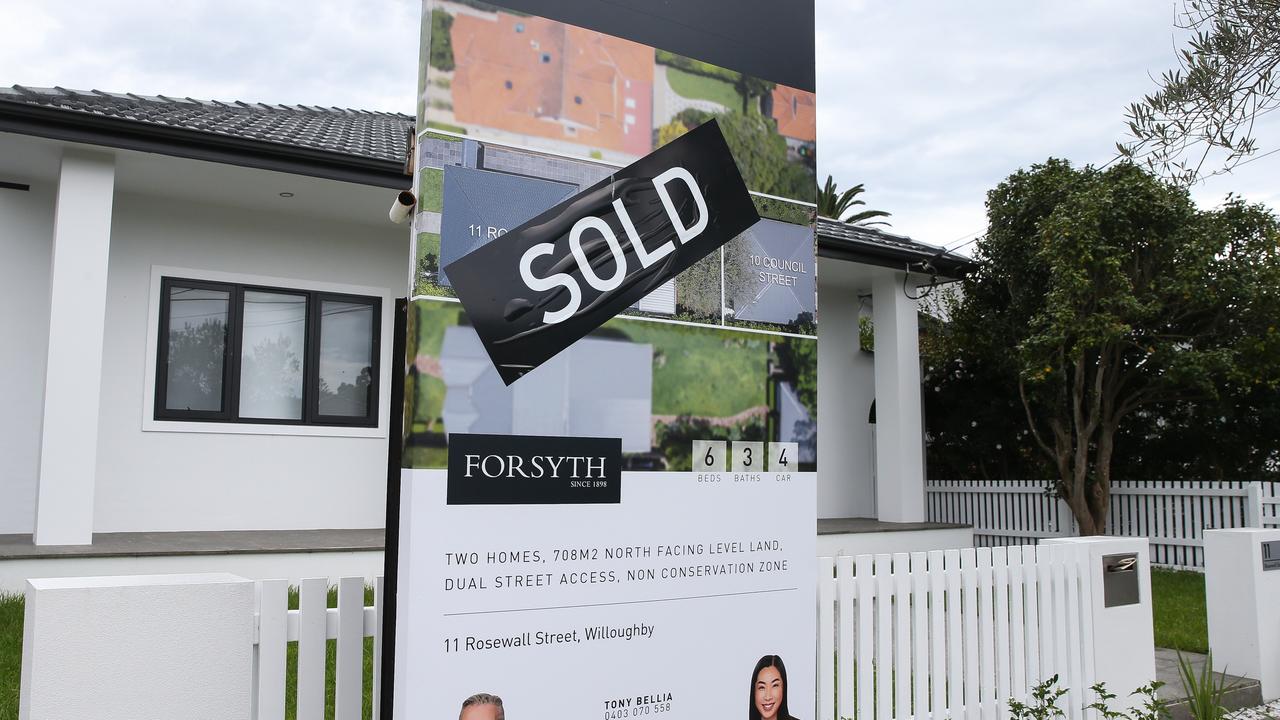Body language expert explores second leaders’ debate
Scott Morrison and Anthony Albanese engaged in a heated debate on Sunday night. Now a body language expert has revealed some things you may have missed.

Federal Election
Don't miss out on the headlines from Federal Election. Followed categories will be added to My News.
The two men vying to be prime minister of Australia stood in front of the nation on Sunday night to answer tough questions – from a panel of journalists and from each other.
But as the election campaign heats up, the second leaders’ debate, hosted by Channel 9, was as much about the spoken word as it was about non-spoken clues.
At times Prime Minister Scott Morrison and Opposition Leader Anthony Albanese appeared confident. At other times they were rattled.
After watching the debate closely, connection and body language expert Katia Loisel said both men expressed discomfort and “there were numerous non-verbal tells that indicated that both leaders were feeling the heat and weight of the campaign”.
“In contrast to the more subdued first leaders’ debate, after a shaky start, it was all gloves off,” Ms Loisel said.

“Normally a polished performer with open body language and expressive hand gestures, the pressures of the campaign have clearly affected Morrison who initially appeared less confident than in the first debate – he seemed rushed, his increased vocal pace, speech errors, single hand gestures, and slight frown suggesting negative emotional arousal and discomfort.
“Likewise, Albanese, who has been crippled by performance anxiety in the past few weeks, also displayed feelings of discomfort.
“His fig leaf display prior to the opening statement, his hands clasped over his groin, clasped hands with interlaced fingers, shifting weight, and lip compression revealing feelings of nervousness and insecurity.”
She said Morrison appeared “less than confident” at the start but “regained his composure”.

“His open palm gesturing, his heart window open, conveying sincerity and honesty essentially saying, ‘You can trust me, I’m here to serve.’
“However, despite Morrison reining in many of his more dominant mannerisms such as the finger point, jaw thrust and head thrust backwards at the beginning of the debate, and adopting more non-threatening and open gestures such as the thumb gesture to articulate his point, as the debate wore on we saw an increase in dominance displays such as jaw jutting, the dominance smile and finger pointing, and signs of aggression, contempt and frustration.”


Ms Loisel explained that human brains are wired to give a disproportional amount of attention to hands, which is why these hand gestures are so important.
“While pointing your finger to make a point triggers a visceral negative response, using a baton gesture with an open vertical hand going up and down or the thumb gesture to make a point emphasises what is being said without being intimidating.”
She said viewers could read plenty by looking at Mr Morrison’s mouth.
“One of the most prominent aspects of Morrison’s non-verbal communication is his mouth. In contrast to the first leaders’ debate in which Morrison reigned in many of his more dominant mannerisms, signs of dominance, contempt and anxiety were more evident during the second leaders’ debate with numerous dominance smile and lip smacking displays.
“Throughout the debate, genuine smiles from Morrison were few and far between, however, what we did see were numerous dominance smile displays.
“A dominance smile is an asymmetrical smile in which one side of the lip raises in a smile with the other downturned or staying put and is a non-verbal threat signalling contempt and dominance.
“The dominant smile has also been shown to increase the heart rate in the receiver and this non-verbal threat coupled with Morrison’s downturned mouth indicating displeasure or sadness adds to a sense of smugness and won’t help his likability.”
She same Mr Albanese “is generally less assertive and aggressive than Morrison” and initially used his body orientation to try to deflect the hostility coming his opponent.
“[He was] essentially turning his back to him, a technique that Morrison later used during the debate. However, as the debate progressed and hostility escalated, Albanese’s clenched jaw jut, change in body orientation towards Morrison and pointed finger suggested rising anger and are an indication of disagreement and suppressed agitation and his body’s subconscious way of saying both ‘no’ and, ‘I’m not afraid to take you on.’”
The body language expert said both Mr Morrison and Mr Albanese “exhibited disappearing compressed lips” which may signal the onset of anger, discomfort, disliking, grief, sadness or uncertainty”.

She said there was a key moment when Mr Morrison was told, “A lot of people don’t like you,” that he showed “a significant non-verbal shift”.
“[We saw] a downturned lip compression, swallowing, a lack of animation and gesturing, and shifting of his weight from side to side signalling discomfort and a subconscious attempt to self-soothe,” Ms Loisel said.
“In particular a small amount of saliva stuck to Morrison’s lips indicates a dry throat and mouth, often caused by stimulation of the sympathetic nervous system and a sign of anxiety and negative emotional arousal.
“Whilst both leaders exhibited significant non-verbal shifts in body language during questioning, Morrison’s non-verbal communication indicated someone who was becoming increasingly rattled, whereas Albanese became more confident as the debate progressed.
“In contrast to his normally polished performance, there were numerous times during the debate that Morrison’s non-verbal communication was indicative of someone who felt that they were losing control, holding on to his wrist signalling frustration and an attempt to regain control, talking over questions, finger pointing, eye blocks, increased vocal pace and speech errors, and the use of pacifying gestures.
“Generally less polished than Morrison, when asked about topics such as the cost of living and housing, and in particular during his closing argument, Albanese appeared more confident and passionate in his response.
“His intertwined fingers unlock, he straightens his posture, lifts his chin and speaks with an open direct posture using his hands to articulate and reinforce his message, indicating a sense of confidence, competence and conviction.”

She said that while Mr Morrison is generally skilled at getting his point across, “he can come across as calculated and lacking in empathy and less authentic than Albanese”.
“The use of the dominance smile display during the debate watered down the effectiveness of Morrison’s communication, making him appear somewhat smug, undoubtably not the outcome that he was going for.”
After more than 30,000 votes, Channel 9 was unable to split the two leaders declaring the event a dead heat.
Those who were able to overcome some technical difficulties voted to give the edge to Morrison initially and then to Albanese before host Sarah Abo declared it too close to call with 50 per cent of the vote each.
The pair will square off again in a third leaders’ debate on Wednesday, May 11.
The event will be aired by Channel 7 and hosted by the network’s political editor Mark Riley. With Channel 7’s broadcast just 10 days before the election, it is unlikely there will be another opportunity for the leaders to go head to head.
The first debate attracted more than 415,000 viewers across Sky News’ subscription and online services, with the viewer count expected to rise in the upcoming two debates on free-to-air TV.
Requests by the ABC to host a debate between the leaders have not yet been granted, despite the public broadcaster putting the call out to both parties.
Originally published as Body language expert explores second leaders’ debate




